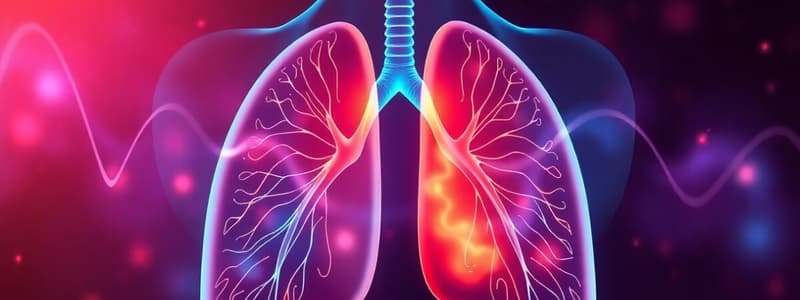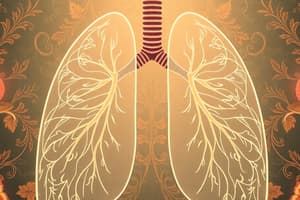Podcast
Questions and Answers
What is the volume of air represented by the Tidal Volume (TV)?
What is the volume of air represented by the Tidal Volume (TV)?
- 500 ml (correct)
- 1200 ml
- 1100 ml
- 3000 ml
Which lung volume is defined as the amount of air that can be maximally expired after normal expiration?
Which lung volume is defined as the amount of air that can be maximally expired after normal expiration?
- Tidal Volume (TV)
- Expiratory Reserve Volume (ERV) (correct)
- Inspiratory Reserve Volume (IRV)
- Residual Volume (RV)
Which of the following is NOT a component of the Vital Capacity (VC)?
Which of the following is NOT a component of the Vital Capacity (VC)?
- Tidal Volume (TV)
- Expiratory Reserve Volume (ERV)
- Residual Volume (RV) (correct)
- Inspiratory Reserve Volume (IRV)
What is the maximum volume of air that can be inspired after normal expiration called?
What is the maximum volume of air that can be inspired after normal expiration called?
What happens to Residual Volume (RV) with aging and in conditions like emphysema?
What happens to Residual Volume (RV) with aging and in conditions like emphysema?
What is the normal value of Total Lung Capacity (TLC)?
What is the normal value of Total Lung Capacity (TLC)?
Which of the following capacities is defined as the sum of Residual Volume (RV) and Expiratory Reserve Volume (ERV)?
Which of the following capacities is defined as the sum of Residual Volume (RV) and Expiratory Reserve Volume (ERV)?
What does the Peak Expiratory Flow Rate (PEFR) measure?
What does the Peak Expiratory Flow Rate (PEFR) measure?
What does FEV1 specifically measure in lung function?
What does FEV1 specifically measure in lung function?
What is the significance of the FVC measurement?
What is the significance of the FVC measurement?
Which of the following diseases is classified as an obstructive respiratory disease?
Which of the following diseases is classified as an obstructive respiratory disease?
Which statement accurately describes a restrictive respiratory disease?
Which statement accurately describes a restrictive respiratory disease?
How do obstructive and restrictive diseases differ in terms of lung function tests?
How do obstructive and restrictive diseases differ in terms of lung function tests?
Flashcards
Tidal Volume (TV)
Tidal Volume (TV)
Amount of air inhaled or exhaled during a normal breath.
Inspiratory Reserve Volume (IRV)
Inspiratory Reserve Volume (IRV)
Extra air that can be inhaled beyond a normal breath.
Expiratory Reserve Volume (ERV)
Expiratory Reserve Volume (ERV)
Extra air that can be exhaled after a normal breath.
Residual Volume (RV)
Residual Volume (RV)
Signup and view all the flashcards
Inspiratory Capacity (IC)
Inspiratory Capacity (IC)
Signup and view all the flashcards
Vital Capacity (VC)
Vital Capacity (VC)
Signup and view all the flashcards
Functional Residual Capacity (FRC)
Functional Residual Capacity (FRC)
Signup and view all the flashcards
Total Lung Capacity (TLC)
Total Lung Capacity (TLC)
Signup and view all the flashcards
FEV1
FEV1
Signup and view all the flashcards
FVC
FVC
Signup and view all the flashcards
FEV1/FVC ratio
FEV1/FVC ratio
Signup and view all the flashcards
Obstructive lung disease
Obstructive lung disease
Signup and view all the flashcards
Restrictive lung disease
Restrictive lung disease
Signup and view all the flashcards
Study Notes
Lung Volumes and Capacities
- Lung volumes and capacities are subdivisions of the total lung volume at maximal inspiration.
- A spirometer records lung volumes and capacities.
Learning Objectives
- Describe lung volumes and capacities
- Explain FEV1 and FVC (and their importance)
- List obstructive and restrictive respiratory diseases
Spirometer
- Records lung volumes and capacities
- Measures breathing
Lung Volumes and Capacities
- The total lung volume is subdivided into volumes and capacities.
Lungs Volumes and Capacities
- Key volumes include: Inspiratory reserve volume, Expiratory reserve volume, Tidal volume, Residual volume.
- Key capacities include: Inspiratory capacity, Vital capacity, Functional residual capacity, Total lung capacity.
Lungs Volumes
- Tidal volume (TV): Amount of air breathed in or out during a quiet respiration. Normal value: 500 ml
- Inspiratory reserve volume (IRV): Maximum amount of air inspired after a normal inspiration. Normal value: 3000 ml
- Expiratory reserve volume (ERV): Maximum amount of air expired after a normal expiration. Normal value: 1100 ml
- Residual volume (RV): Amount of air remaining in the lungs after a maximal expiration. Normal value: 1200 ml
Lung Capacities
- Inspiratory capacity (TV + IRV): Maximum volume of air that can be inspired after a normal expiration. Normal value: 3500 ml
- Vital capacity (TV+IRV+ERV): Maximum volume of air that can be forcefully expelled from the lungs following a maximum inspiration. Normal value: 4600 ml
- Functional residual capacity (RV+ERV): Volume of air remaining in the lungs at the end of a normal expiration. Normal value: 2300 ml
- Total lung capacity (TV+IRV+ERV+RV): Volume of air contained in the lungs at the end of a maximal inspiration. Normal value: 6000 ml
Expiratory Flow Rate
- Also known as peak expiratory flow rate (PEFR).
- Recorded using a peak flow meter where the subject exhales maximally for 10 milliseconds.
- Expressed for one minute.
- Normal value: 400 L/minute.
- PEFR measures air flow obstruction in larger airways (e.g., asthma).
Forced Vital Capacity (FVC)
- Total volume of air exhaled forcefully from total lung capacity.
- Most of the FVC is exhaled in <3 seconds, but it can be prolonged in obstructive diseases.
- Measured in liters (L).
Forced Expiratory Volume (FEV₁)
- When forced vital capacity is measured in the first second, it's known as FEV1
- Normal subjects expire 85% in 1 second and 97% in 3 seconds
- FEV₁ measurement is useful for detecting obstructive and restrictive pulmonary diseases.
- In obstructive pulmonary disease, FEV₁ is reduced.
- In restrictive pulmonary disease, FVC is reduced.
Respiratory Diseases
- Obstructive: Asthma, COPD (Chronic bronchitis & Emphysema), Cystic fibrosis
- Restrictive: Interstitial lung fibrosis, heart failure, lung edema, Pulmonary tuberculosis, pneumonia, pneumothorax, extreme obesity, pregnancy
Learning Resources
- Textbook: Hall, John E. Guyton and Hall textbook of medical physiology, 14th edition, 2021, Chapter 38, 491-501
- Website: https://www-clinicalkey-com.gmulibrary.com/#!/content/book/3-s2.0-B9780323597128000382?indexOverride=GLOBAL
- Powerpoint presentation in Moodle
Studying That Suits You
Use AI to generate personalized quizzes and flashcards to suit your learning preferences.




